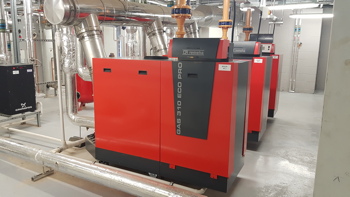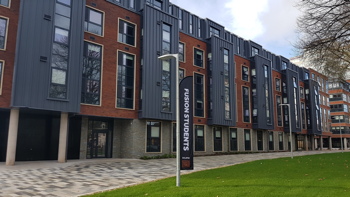Adding CHP to the mix

Mike Hefford examines the benefits of using combined heat and power as the source for heat networks, and how they can be optimised for efficiency and sustainability.
To reduce carbon and cut heating bills, the government has committed to building and extending heat networks across the country, underpinned by public funding until 2021.
At Remeha, we define a heat network as utilising renewable or low carbon gas-fired equipment operating on low temperatures to distribute heat to a number of domestic or non-domestic buildings. In contrast, a district heating network is typically associated with higher temperatures and a varied heat source from process or large industrial sites.
Most modern heat networks currently serve one or more buildings with multiple occupants from a central energy plantroom. In individual multiple-occupancy buildings, such as residential developments, heating and hot water are typically controlled by the end user using heat interface units (HIUs).
While a number of different heat sources can be used in a heat network, a low carbon technology like combined heat and power (CHP) can dramatically reduce both energy costs and emissions.
CHP operates by converting a single fuel – usually natural gas – into both electricity and heat in a single process at the point of use. This ability to generate heat and power simultaneously makes CHP approximately 30% more efficient than relying on traditional heating plant and electricity supplied solely from the grid. In addition to the lower energy costs and improved environmental performance, CHP provides greater energy security for building owners and operators, reducing reliance on carbonbased energy while producing electricity at gas prices.
 |
|
The Eclipse student accommodation plantroom fitted with Remeha boilers |
Collaborating for efficiency
As with all technology, the end performance of CHP in a heat network is determined by its application. So how to maximise the efficiency of a CHP-powered heat network?
A heat network will typically integrate CHP with a combination of heat sources – for example, gas-fired condensing boilers, gas absorption heat pumps or HIUs.
Successful integration of the equipment is essential to achieve an effective heat network that delivers the anticipated financial or carbon savings – and this begins at the design stage.
However, designers can’t be expected to know every detail about every product. But by tapping into the expert product knowledge of experienced suppliers at the early stages, and using them as a technical resource, designers could save themselves time and fees while maximising system efficiency.
Take the feasibility study, the starting point of any heat network using CHP as the main heat source. Good suppliers will be able to provide an informed CHP advisor to assist with the scoping. At this point, they can also answer fundamental questions that may help shape the design philosophy. Is CHP the right solution for the unique requirements of this heat network? Have the features, usage patterns and infrastructure been taken into account? Is the heat network future-proofed to meet future energy demands?
Sharing the heat load
The next consideration is sizing. Accurate sizing is essential to minimise the total costs of energy supply for the site. How the CHP is sized will determine the design as condensing boilers may need to be specified alongside to meet peak demand. Is the CHP sized on thermal output or electrically led? This may influence the decision to use buffer vessels to smooth the heat demand, reduce boiler use and maximise electricity production.
During the feasibility study, baseload calculations have traditionally been the best way to size CHP both electrically and thermally. However, the need to meet compliance tends to lead to oversizing CHP – which will cause the unit to shut down when demand is low.
Unfortunately, there is no straightforward way to size CHP as each project needs to be assessed on a separate basis. So, consulting with suppliers early enough may help designers to achieve the optimum sizing for each individual application.
While each heating system should be designed specifically to meet the requirements of a building, experienced suppliers are likely to have seen a similar scenario before. As a result, they may be able to supply schematics or exemplar designs that illustrate the overall design philosophy, saving time and fees. Perhaps most importantly, having seen the end result, they may also be able to advise against possible pitfalls.
Will combining CHP with a certain technology affect the overall efficiency of the heat network? Sometimes achieving the most effective outcome comes down to asking the supplier the right questions at the right time.
 |
|
Eclipse luxury student accommodation in Cardiff powered by Remeha CHP |
Defend the design
Encouraging greater collaboration between the project team from the outset helps the project team buy into the design, preventing potentially detrimental value engineering. For example, HIUs offer numerous benefits in heat networks serving residential properties as they are easy to install and maintain. However, if one particular HIU model performs better than another at lower temperature circuits, switching the specified product on a 70°C/40°C CHP-led heat network design could adversely affect system performance.
Tailored control solution
Building Services Compliance Regulations stipulate that CHP in new and existing buildings should have a control system that, as a minimum, ensures that the CHP unit operates as the lead heat generator. But this is just the starting point. To ensure that the heat network functions as conceived, achieving the maximum efficiencies and savings, a holistic approach to system control is required.
As the various components in a heat network design may have unique temperature limitations, engaging with the supplier early in the project is particularly important. They advise on how best to control the system to optimise performance.
Towards a low carbon future
The Association for Decentralised Energy (ADE) says that gas CHP will continue to reduce carbon emissions by up to 30% far into the 2030s. Heat networks powered by CHP can offer reliable, easy-to-maintain heating solutions that will deliver energy and emission savings and greater resilience. The Energy Technology Institute suggests that nearly half the UK’s existing heat demand could be economically connected to heat networks.
As such, heat networks powered by CHP offer huge opportunities for the building services sector – especially if a more collaborative approach is adopted from the outset to ensure that the significant potential benefits are achieved.
Mike Hefford is Remeha CHP’s general manager








